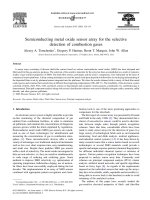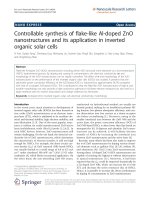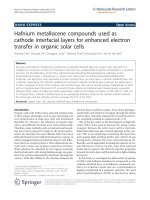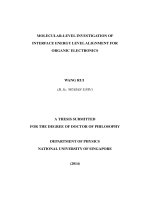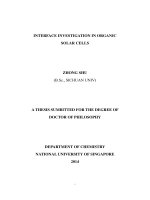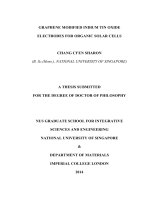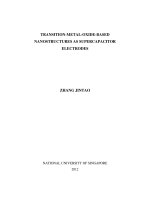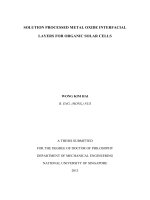Solution processed metal oxide interfacial layers for organic solar cells
Bạn đang xem bản rút gọn của tài liệu. Xem và tải ngay bản đầy đủ của tài liệu tại đây (23.07 MB, 159 trang )
SOLUTION PROCESSED METAL OXIDE INTERFACIAL
LAYERS FOR ORGANIC SOLAR CELLS
WONG KIM HAI
B. ENG. (HONS.) NUS
A THESIS SUBMITTED
FOR THE DEGREE OF DOCTOR OF PHILOSOPHY
DEPARTMENT OF MECHANICAL ENGINEERING
NATIONAL UNIVERSITY OF SINGAPORE
2013
i
Dedicated to my dear parents, brother and fiancée
“You must be the change you seek in the world.”
Mahatma Gandhi
“All truths are easy to understand once they are
discovered; the point is to discover them.”
Galileo Galilei
“If I have seen further than others, it is only by
standing on the shoulders of giants.”
Isaac Newton
ii
iii
Acknowledgements
The work presented in this dissertation is based on my research experience in the
National University of Singapore during the period August 2009 - July 2013. This
experience has been enriched by memorable individuals to whom I’d like to express my
sincere gratitude. I would like to thank my supervisor, Dr Palani Balaya, for giving me
the independence, support and opportunity to work under his guidance. Scientific
discussions and facilities provided by SERIS are sincerely acknowledged. I am also
grateful to Associate Professor Ouyang Jianyong for extending prompt support in my
final year when I was unable to carry out research at SERIS due to unfortunate and
unforeseen circumstances. Financial support in the form of a Ph.D. scholarship award
from the Singapore National Research Foundation (Energy Innovation Program Office) is
also gratefully acknowledged.
My special thanks to the staff, colleagues and friends of the Alternative Energy
Sources Laboratory, SERIS and Materials Science Department with whom I have had the
privilege to work with - in no order of preference: Prof. Dr. Joachim Luther, Dr.
Satyanarayana Reddy Gajjela, Dr. Sankar Devaraj, Dr. K. Ananthanarayanan, Dr.
Senthilarasu Sundaram, Dr. Doddahalli H. Nagaraju, Dr. Mirjana Kuzma, Chad William
Mason, Marc Daniel Heinemann, Neo Chin Yong, Yong Chian Haw, Laxmi Narasimha
Sai Abhinand Thummalakunta, Heng Li Shan, Liew Yong Hua and Cindy Tang Guan Yu,
among others.
Finally, my deepest thanks go to my parents, brother and Michelle for their
unconditional love and support.
iv
Table of Contents
Acknowledgements iii
Table of Contents iv
Summary…………………………………………………………………………… ix
List of Publications xi
International Journals xi
Conference Participations xi
List of Figures xiii
List of Tables xxii
List of Symbols and Constants xxiv
Copyright permissions xxvii
Chapter 1 Introduction 1
1.1 Energy Situation 1
1.2 Solar Photovoltaics 2
1.3 Photovoltaic Technologies 3
1.3.1 Wafer-based Crystalline Si Solar Cells 3
1.3.2 Organic Photovoltaics 3
References 7
Chapter 2 Fundamental Concepts and Literature Review 9
2.1 Preface 9
2.2 Band structure 9
2.3 Thermal equilibrium in a semiconductor 10
2.4 Semiconductors under illumination 13
v
2.5 Organic semiconductors – conjugated molecular systems 14
2.6 The bulk heterojunction 16
2.7 Operating principle of OPV 18
2.8 Interfacial layers 22
2.8.1 Mechanisms for charge selectivity of interfacial layers 22
2.8.2 Important prerequisites for interfacial layers 24
2.8.3 Poly(3,4-ethylenedioxythiophene):poly(styrenesulfonate) (PEDOT:PSS) – the
standard hole extraction layer 25
2.9 Motivation 27
2.9.1 Metal oxides interfacial layers 27
2.9.2 Solution processing metal oxide interfacial layers 28
2.9.3 Objective of This Work 30
References 32
Chapter 3 Experimental Details 37
3.1 Materials 37
3.1.1 Conducting glass substrates 37
3.1.2 Preparation of active layer and metallisation 37
3.2 Characterisation 38
3.2.1 Atomic force microscopy 38
3.2.2 Field emission scanning electron microscopy 38
3.2.3 X-ray diffraction 39
3.2.4 X-ray photoemission spectroscopy 39
3.2.5 Ultraviolet photoemission spectroscopy 40
3.2.6 I-V measurement 40
vi
3.2.7 Intensity modulated photocurrent spectroscopy and electrochemical
impedance spectroscopy 41
Chapter 4 Enhanced photocurrent, stability and the effect of parasitic resistances
using solution-based NiO interfacial layer 43
4.1 Introduction 43
4.2 Experimental Details 44
4.2.1 Materials 44
4.2.2 NiO film deposition and device fabrication 44
4.3 Results and Discussion 46
4.3.1 Device performance 46
4.3.2 Structural and elemental characterization 48
4.3.3 Effect of parasitic resistances and enhanced photocurrent 49
4.3.4 Effect of heat treatment on ITO 51
4.3.5 Device stability – a study by IMPS 52
4.4 Conclusions 55
References 56
Chapter 5 Origin of Hole Selectivity and the Role of Defects in Low Temperature
Solution-Processed MoO
x
Interfacial Layer for Organic Solar
Cells………………………………………………………………………………… 58
5.1 Preface 58
5.2 Introduction 59
5.3 Experimental Section 61
5.3.1 Materials 61
5.3.2 MoO
x
film deposition and device fabrication 61
5.3.3 Electrochemical Impedance Spectroscopy 62
vii
5.4 Results and Discussion 62
5.4.1 Device performance 62
5.4.2 Structural and elemental characterisation 66
5.4.3 Mechanism of hole selectivity in high work function MoOx interfacial layers
70
5.5 Conclusions 75
References 76
Chapter 6 Aqueous electrodeposited WO
x
hole transport layer for organic solar
cells……………………………………………………………………………………81
6.1 Preface 81
6.2 Introduction 82
6.3 Experimental Details 83
6.3.1 Materials 83
6.3.2 Preparation of WO
x
films by spin coating 84
6.3.3 Preparation of WO
x
films by cathodic reduction of peroxo-tungstate precursor
84
6.3.4 Preparation of WO
x
films by anodization 85
6.3.5 OPV cell fabrication and property measurement 86
6.4 Results and Discussion 86
6.4.1 Spin coated WO
x
films 86
6.4.1.1 Device performance 86
6.4.1.2 Effect of heat treatment & impurities – elemental analysis 87
6.4.2 Electrodeposited WO
x
films: peroxo-tungstate precursor 89
6.4.2.1 Structural & elemental characterization 91
6.4.2.2 Device performance 95
viii
6.4.3 WO
x
films prepared by anodization of W metal 97
6.5 Conclusions 100
References 102
Chapter 7 Aqueous Electrodeposition of TiO
x
Electron Selective Interfacial Layers
for Inverted Organic Solar Cells 105
7.1 Preface 105
7.2 Introduction 106
7.3 Experimental Details 108
7.3.1 Materials 108
7.3.2 Precursor Synthesis 108
7.3.3 TiO
x
Electrodeposition and Device Fabrication 109
7.4 Results and Discussion 110
7.4.1 Elemental analysis 110
7.4.2 Structural characterization 114
7.4.3 Device performance 116
7.4.3.1 Annealing environment for TiO
x
interfacial layer 116
7.4.3.2 Optimising TiO
x
thickness 118
7.5 Conclusions 120
References 122
Chapter 8 Conclusions and Future Work 126
8.1 General conclusions 126
8.2 Future Work 128
References 131
ix
Summary
Organic photovoltaic devices (OPV) have been the subject of intense research as a
potential source of renewable energy due to its potential to meet requirements of cost
effective manufacturing and its relevance for lightweight and flexible applications. The
results presented in this dissertation are focused on exploring wet chemical or solution
processes to fabricate metal oxide films that function as interfacial/passivation layers in
organic solar cells. Such methodologies have led to the discovery of simple pathways
toward enhancing the performance of OPVs.
Chapter 1 presents an overview of the current energy situation and general
introduction to different photovoltaic technologies.
Chapter 2 describes the fundamental concepts of semiconductor materials,
interfaces and the operating principle of OPV. An extensive literature review is provided
before the motivation for this research is presented.
In Chapter 3, all experimental details - materials, device fabrication and
characterisation techniques – related to this dissertation are described.
Chapter 4 reports on the use of NiO as a hole extraction layer. The fabrication
approach is based on thermal decomposition of a Ni salt. The photovoltaic performance
of corresponding NiO based OPV devices were correlated to parasitic resistances. The
limitations of the thermal decomposition approach as well as improvements in passivation
and lifetimes due to NiO are discussed. Degradation was studied by IMPS and the results
are discussed in terms of charge transport and recombination.
In Chapter 5, a low temperature solution process for the fabrication of MoO
x
hole
extraction layer is introduced. This approach involved the use of an acid to precipitate the
formation of MoO
x
films during spin coating. The electrical properties of the MoO
x
films
and corresponding devices are discussed in relation to post-deposition annealing
x
treatments, with specific focus on O vacancy doping. Energy level measurements were
performed to reveal high work functions as well as an n-type nature in the MoO
x
films
fabricated, despite their hole selective nature. A mechanism for hole selectivity is
discussed in relation to the high work function and gap states due to O vacancy doping in
the n-type MoO
x
films.
Aqueous electrodeposition forms the focus of Chapters 6 & 7. Beginning with
WO
x
in Chapter 6, films prepared by electrodeposition based on acid chemistry is
compared with the films prepared by spin coating based on the precipitation approach as
discussed in Chapter 5. Electrodeposition offered an effective means of removing cationic
impurities introduced by the precursor as well as refined thickness control at increments
of 3-5 nm. The effects of interfacial layer roughness on device performance are discussed.
Extending electrodeposition to TiO
x
as an electron extraction layer for the inverted OPV
device structure, Chapter 7 discusses aqueous electrodeposition of highly smooth and
conformal TiO
x
films on ITO substrates. The deposition mechanism is discussed in
relation to electrogenerated OH
-
species. The influence of H
2
O
2
and NO
3
-
additives used
for OH
-
electrogeneration on the morphology of the TiO
x
films is discussed. Although an
n-type semiconductor like MoO
x
and WO
x
, O vacancy introduction was found to be
detrimental for device performance in the case of TiO
x
. This is discussed in reference to
electron tunnelling barriers at the ITO/TiO
x
interface. The TiO
x
devices were completed
with solution processed PEDOT:PSS to realise fully solution processed inverted OPV
devices.
Finally, some conclusions with outlook into the future of research and
development of highly efficient OPV are drawn in Chapter 8.
xi
List of Publications
International Journals
1. “Low Temperature Aqueous Electrodeposited TiO
x
as Electron Extraction Layer
in Inverted Organic Solar Cells”, K. H. Wong, C. W. Mason, S. Devaraj, J.
Ouyang and Palani Balaya (manuscript submitted).
2. “Electrodeposited WO
3
modified indium-tin-oxide anodes as Hole Extraction
Layer for Enhancing Efficiency and Stability of Organic Solar Cells”, K. H.
Wong, C. G. Y. Tang, J. Ouyang and Palani Balaya (manuscript in preparation).
3. "The First Report on Excellent Cycling Stability and Superior Rate Capability of
Na
3
V
2
(PO
4
)
3
for Sodium Ion Batteries" K. Saravanan, C. W. Mason, A. Rudola,
K. H. Wong and P. Balaya, Adv. Energy Mater., 2013 (3) 444.
4. "Enhanced photocurrent and stability of organic solar cells using solution-based
NiO interfacial layer", K. H. Wong, K. Ananthanarayanan, M. D. Heinemann, J.
Luther, P. Balaya, Solar Energy, 2012 (86) 3190.
5. "Origin of Hole Selectivity and the Role of Defects in Low Temperature Solution-
Processed Molybdenum Oxide Interfacial Layer for Organic Solar Cells", K. H.
Wong, K. Ananthanaranayan, P. Balaya, J. Phys. Chem. C, 2012 (116) 16346.
Conference Participations
1. “Solution Processed Metal Oxide Interfacial Layers for Organic Solar Cells”, K. H.
Wong, C. G. Y. Tang, O. Jianyong, P. Balaya, MRS Spring Meeting and Exhibit
2013, San Francisco, USA, 2013.
2. “Energy Conversion using Nano-structured Solar Sells”, S. R. Gajjela, K. H.
Wong, K. Ananthanarayanan and P. Balaya. The 36th International Conference &
Exposition on Advanced Ceramics & Composites, Florida, USA, 2012.
xii
3. “Solution Processed NiO Films and Their Performance as the Anode Interfacial
Layer In P3HT:PCBM Organic Solar Cells”, K. H. Wong, K. Ananthanarayanan,
M. D. Heinemann and P. Balaya, VIII International Krutyn Summer School,
Krutyn, Poland, 2011.
4. “Energy Conversion using Nanostructured Solar Cells”, S. R. Gajjela, K. H.
Wong, S. Senthilarasu, K. Ananthanarayanan and P. Balaya, 4
th
Asian Conference
on Electrochemical Power Sources, Taiwan, 2009.
xiii
List of Figures
Figure 1.1. Best research cell efficiencies. Adapted from [4]. 2
Figure 1.2. Schematic of a typical OPV roll-to-roll machine. 4
Figure 1.3. (a) Schematic structure of ultralight and flexible OPV. (b) Extreme flexibility
of device demonstrated by wrapping it human hair (radius 35 μm). (c) Solar cells are
compressed in linear fashion to 30% (middle) and 50% (right). (d) OPV device
under three-dimensional deformation over a 1.5 mm-diameter plastic tube (scale bar
2mm). Adapted from [19]. 6
Figure 1.4. Different products based on OPV technology: a) textile shade, b) building
integrated power curtains, c) semi-transparent rigid shades and d,e) portable
electronics [20] 6
Figure 2.1. A schematic representation of the band structures of metals, semiconductors
and insulators. Electrons found in the valence band are not available for current
conduction while those in the conduction band are available. The valence and
conduction bands are separated by a band gap. The definition of metals,
semiconductors and insulators corresponds closely with the size of the band gaps.10
Figure 2.2. Schematic representation of metal/n-type semiconductor interfaces at thermal
equilibrium (ϕ
m
: metal work function, ϕ
s
: semiconductor work function, CB:
conduction band edge, VB: valence band edge, E
vac
: vacuum line). 12
Figure 2.3. Schematic representation of metal/p-type semiconductor interfaces at thermal
equilibrium (ϕ
m
: metal work function, ϕ
s
: semiconductor work function, CB:
conduction band edge, VB: valence band edge, E
vac
: vacuum line). 13
Figure 2.4. Schematic representation of the Fermi levels of semiconductor at thermal
equilibrium in the dark (left) and under illumination (right). The excitation of an
xiv
electron from the valence band into the conduction band by an energetic photon
results in the formation of an electron-hole pair. 13
Figure 2.5. Molecular structures of polymers (drawn in square brackets) and small
molecules commonly used in OPV [3, 4]. 16
Figure 2.6. Schematic plot of exciton binding energy as a function of charge separation
distance (redrawn from [5]). Free charge carriers are spontaneously generated in
conventional inorganic semiconductors because the electron wave function extends
beyond the coulombic radius (r
c
) at kT. In OSCs, however, the electron wave
function is highly localized and found deep in the potential well. Since it is
significantly smaller than r
c
, the electron-hole pair is electrostatically bound and free
carriers are not generated at room temperature. 16
Figure 2.7. Schematic representation of exciton dissociation at a donor/acceptor
heterojunction (left) and at a semiconductor/metal heterojunction (right). The
donor/acceptor heterojunction creates a thermodynamically favourable environment
for efficient charge separation. 17
Figure 2.8. Schematic representation a bulk heterojunction (BHJ) comprised of a polymer
donor and fullerene acceptor (image courtesy of C. Deibel:
). The primary steps in are (i) photogeneration of an
exciton, (ii) diffusion of exciton to donor-acceptor interface where (iii) spontaneous
charge transfer from donor to acceptor, (iv) charge separation of geminate pair, (v)
charge transport through percolated pathways and (vi) charge extraction at
electrodes. Each of the above steps is accompanied by recombination processes that
compete with photocurrent generation i.e. exciton recombination, geminate pair
recombination, recombination of free carriers with other mobile or trapped charges
in the BHJ or electrodes. The ideal BHJ network is one that allows excitons to
xv
diffuse readily to a donor-acceptor interface, is highly percolated and contains
minimum isolated pockets. 21
Figure 2.9. Illustration in energy scale of (a) photogeneration (b) charge separation (c)
charge transport (d) charge collection processes in an OPV and (e) elementary steps
describing the operating principle of OPV. Adapted from [4]. 21
Figure 2.10. Interfacial layers are used to provide an intermediate energy step so that
ohmic pathway to the external circuit for one out of the two carriers in the
photoactive layer is formed. The hole/electron selective interfacial layer is used to
spatially separate electrons/holes in the active layer from holes/electrons in the
anode/cathode. Adapted from [14]. 23
Figure 2.11. Schematic diagrams of the conventional (left) and inverted (right)
architecture of OPVs. In both case, photons are incident from the transparent
conducting substrate 24
Figure 4.1. Schematic of the work flow for the preparation of NiO (left) and PEDOT:PSS
(right) devices. 45
Figure 4.2. Schematic representation of the device structure of as-prepared NiO devices
and the chemical structures of P3HT donor and PCBM acceptor used in this study
(top left), energy level diagram of the NiO devices (top right) and J-V characteristics
of devices utilizing PEDOT:PSS and NiO interfacial layers fabricated in this study.
46
Figure 4.3. A plot of device parameters (V
oc
, J
sc
, FF and η) against thickness of the NiO
interfacial layer. Data presented is based upon those tabulated in Table 4.1. 47
Figure 4.4. AFM height images of ITO (top, left), ITO/NiO (top, right) and cross
sectional SEM reveals the formation of dense NiO films on ITO. The RMS
roughness of the NiO films was measured to be 0.9-1.3nm. 48
xvi
Figure 4.5. (a) XPS spectra recorded for Ni 2p showing peaks corresponding to NiO, (b)
XPS spectra recorded for C 1s and (c) transmittance spectra for ITO/PEDOT:PSS
and ITO/NiO films of various thickness. 49
Figure 4.6. Dark J-V measurements of NiO and PEDOT:PSS based devices. 50
Figure 4.7. SEM images of 25nm (left) and 15nm (right) NiO films revealed the
formation of microscopic cracks for films δ
NiO
< 25nm. 51
Figure 4.8. Stability test results of unencapsulated NiO and PEDOT:PSS based devices in
dark ambient conditions (25
o
C, 50% RH). 52
Figure 4.9. The Bode Im(J) plot of IMPS measurements performed on PEDOT:PSS and
NiO based devices performed at different times during degradation. 54
Figure 4.10. Quantum efficiency measurements made of degrading devices with
PEDOT:PSS and NiO HEL. 54
Figure 5.1. J-V curves of PEDOT:PSS and MoO
x
(180
o
C, 30 min in N
2
) BHJ devices with
LiF/Al and Ca/Al cathodes for comparison. 64
Figure 5.2. J-V curves of MoO
x
devices, showing the effect of MoO
x
annealing in air and
N
2
conditions at various temperatures. MoO
x
films annealed in air display a
characteristic S-kink and poor performance. Gentle annealing in N
2
however,
removes the S-kink and greatly improves FF and η. 64
Figure 5.3. Device stability test of encapsulated devices soaked under a halogen lamp
(open symbols, 1 Sun, 50
o
C) and in dark, ambient conditions (closed symbols, 25
o
C, 40% RH). 65
Figure 5.4. Thin film XRD of ITO/MoO
x
substrates thermally annealed at 160
o
C
,
200
o
C
and 300
o
C for 10min in air. The films do not display crystalline peaks (indicated by
pink columns extracted from JCPDS #852405) with peaks corresponding to only the
ITO substrate detected. 66
xvii
Figure 5.5. 2 x 2 μm atomic force micrographs were used to determine RMS roughness
(3D height image, left) and image the morphology of the as-prepared MoO
x
films
(phase image, right). 66
Figure 5.6. (a) The Tauc plot of (αhν)
1/2
versus hν was used extract a band gap of 3.7eV
for the as-prepared MoO
x
films, where α is the absorption coefficient and hν is
photon energy; (b) transmittance of ITO, MoO
x
deposited on ITO (ITO/MoO
x
), and
PEDOT:PSS deposited on ITO (ITO/PEDOT:PSS). 67
Figure 5.7. Mo 3d XPS spectra for as-prepared MoO
x
interfacial layers annealed in air
and N
2
. Low temperature annealing in a N
2
atmosphere causes the formation of Mo
5+
and Mo
4+
species, associated with O-vacancies. 68
Figure 5.8. a) UPS measurements of as-prepared MoO
x
interfacial layers annealed in air
and N
2
at 180
o
C for 30min and b) closer view of UPS measurements for the MoO
x
interfacial layers that reveals emissions from gap states for the sample annealed in
N
2
. The black lines demarcate emission onset and secondary cut-off values used to
extract valance band edge and work function values. The binding energy is given
with respect to the Fermi level. 69
Figure 5.9. Energy level structure of as-prepared MoO
x
interfacial layers, determined by
UPS measurements. 70
Figure 5.10. UV-vis-NIR absorption spectra showing broad absorption (charge transfer
band) in ITO/MoO
x
/P3HT, ITO/MoO
x
/PCBM and ITO/MoO
x
/P3HT:PCBM samples.
The results have been normalized to the absorption of ITO/MoO
x
to identify the
absorption of the organic layer and the corresponding MoO
x
/organic interface. . 71
Figure 5.11. Energy level diagram for BHJ OPV devices, illustrating electron transfer
through MoO
x
gap states and the electron-limiting surface field formed at the
MoO
x
/organic interface for devices under illumination. 72
xviii
Figure 5.12. EIS measurement results of illuminated MoO
x
devices incorporating N
2
-
annealed MoO
x
interfacial layers are shown for various potentials between 0.1 – 0.5
V. The Nyquist plots are presented in (a) and (b), which is a magnified view of the
region close to the origin. The Bode plot is presented in (c). The maxima in the Bode
plot may be used to extract relevant time constants. The scatter plots are that of the
raw measurement data, and the solid lines are fits based on the model shown in (d).
The fitting error is < 2 %. 73
Figure 5.13 shows the difference in goodness of fit of the potentiostat EIS measurements
from air-annealed MoO
x
devices using a) Leever’s model and b) extended-Leever’s
model. For both the Nyquist (b, e), Bode plots (c, f), Leever’s model, which
describes only two time constants, failed to provide a satisfactory fit. The raw data,
however, displayed three time constants that were attributed to geometric relaxation
time, non-geminate recombination in the BHJ and non-geminate recombination at
the MoO
x
/BHJ interface. 74
Figure 6.1. Schematic representation of WO
4
2-
ionic precursor and the spin coating
process involving protons to form WO
x
interfacial layers. 84
Figure 6.2. Schematic of three-electrode setup used in this study. ITO was used as
working electrode while a Pt-foil electrode was used as the counter electrode. 85
Figure 6.3. J-V performance of P3HT:PCBM devices fabricated using WO
x
annealed at
various conditions. 87
Figure 6.4. W 4f XPS spectra of Na
2
WO
4
powder (precursor, bottom), as-deposited WO
x
films annealed in air (middle) and as-deposited WO
x
films annealed in N
2
(top) at
200
o
C. The results confirmed the successful deposition of WO
x
films with the
absence of Na
2
WO
4
impurities. 88
xix
Figure 6.5. Schematic diagram of the peroxo-tungstate precursor and ingredients (H
+
&
voltage source) necessary for WO
x
electrodeposition. 89
Figure 6.6. Typical current-voltage response measured during WO
x
electrodeposition
(left). In the anodic cycle, blue films corresponding to the deposition of
electrochromic M
x
WO
3
(where M: Na
+
or H
+
) on ITO were observed. The cations
were removed by applying a cathodic potential to obtain a bleached transparent film.
90
Figure 6.7. Top: W 4f XPS results of electrodeposited WO
x
interfacial layers. The
binding energies correspond to that of WO
x
, showing the successful
electrodeposition of WO
x
films. Bottom: Na 1s XPS spectra of electrodeposited and
spin coated WO
x
samples. The results showed the successful removal of Na
+
impurities in electrodeposited WO
x
films by applying a positive anodic potential
after film deposition. 91
Figure 6.8. Thickness of electrodeposited WO
x
films with respect to number of deposition
cycles performed by cyclic voltammetry. 92
Figure 6.9. AFM images of the ITO substrate and electrodeposited WO
x
films used in this
study. 93
Figure 6.10. XRD results for electrodeposited WO
x
films annealed at various
temperatures in air. ITO peaks are marked by (*). 93
Figure 6.11. UV-vis measurements of ITO and ITO/WO
x
films (left) were used to
calculate %WAT of the ITO/WO
x
films across the thicknesses studied. A Tauc plot
(right) was used to extract the band gap of the as deposited WOx films, which was
determined to be ~3.6 eV. 95
Figure 6.12. This image shows the impact of interfacial layer roughness on the contact
between the BHJ and WO
x
interfacial layer. Smooth and uniform morphology of the
xx
WO
x
interfacial layer encourages intimate electrical contact at the BHJ/WO
x
interface (top) while increased roughness led to increase in R
s
due to the presence of
voids, which act as dead zone that forbid current conduction. 96
Figure 6.13. J-V curves of WO
x
devices, showing the influence of WO
x
thickness on
device performance (left). The corresponding device efficiencies are shown (right).
The window of opportunity for maximum device performance is narrow, thus
highlighting the unique advantage of precise thickness control which
electrodeposition offered in this study. 97
Figure 6.14. SEM images of surface (left) and cross section (right) of anodized WO
x
films, showing the effect of solvent mixture ((a) 10 % H
2
O : 90 % NMF, (b) 20 %
H
2
O : 80 % NMF, (c) 30 % H
2
O : 70 % NMF, (d) 40 % H
2
O : 60 % NMF). Scale
bars are in 1 μm. Figure adapted from [15]. 99
Figure 6.15. SEM images of electroplated W metal and WO
x
films formed by anodic
oxidation of the W metal in DMF, H
2
O and ethylene glycol electrolytes (clockwise
order). 100
Figure 7.1. Schematic representations of the conventional (left) and inverted (right) OPV
device structures 106
Figure 7.2. A photograph taken during electrodeposition of TiO
x
performed with ITO
working electrode, Pt-foil counter electrode, SCE reference electrode and orange-
yellow peroxotitanium oxalate precursor. 109
Figure 7.3. The thickness of TiO
x
films obtained by electrodeposition measured against
the deposition pulse duration used in this study. 110
Figure 7.4. XPS results of Ti core level scan. The results revealed the presence of only
Ti
4+
in the electrodeposited films. 111
xxi
Figure 7.5. Results of the O 1s core level XPS scan for a) as-deposited and unannealed
and b) annealed TiO
x
films prepared by electrodeposition in this study. 112
Figure 7.6. Results of C 1s core level XPS scan of a) as-deposited and b) annealed TiO
x
films prepared by electrodeposition in this study. 113
Figure 7.7. Schematic representation of eletrogeneration of OH
-
from H
2
O
2
and NO
3
-
additives, and the mechanism for precipitation of TiO
x
accompanied by release of
the oxalate ligand back into solution. 113
Figure 7.8. AFM images of a,b) ITO substrates; c,d) the corresponding electrodeposited
TiO
x
films with H
2
O
2
additive and e) TiO
x
films with NO
3
-
additive. Note the height
bar for a-d is given in the top right while that for image e is given in inset. 115
Figure 7.9. The results of the transmittance of ITO and ITO/TiO
x
stacks measured against
various TiO
x
thicknesses. 116
Figure 7.10. Schematic diagram of TiO
x
/BHJ interface, and the influence of trap states on
electron tunnelling at the ITO/TiO
x
interface (adapted from [38]). In essence, trap
states in the TiO
x
EEL are unoccupied before solar irradiation. UV photons captured
by the TiO
x
layer excites electrons and causes the trap states to fill and the
conduction band shifts down towards the Fermi level. This reduces the electron
barrier width and allows tunnelling of photogenerated electrons that in turn enables
photocurrent to be extracted. 118
Figure 7.11. Measured J-V curve of ITO/TiO
x
/P3HT:PCBM/5nm MoO
x
/Al iOPV devices.
118
xxii
List of Tables
Table 2.1. Summary of techniques and their salient features used to prepare metal oxide
films. 27
Table 3.1. Technical specifications of ITO substrates used in this study. 37
Table 4.1. Summary of photovoltaic parameters measured in relation to NiO interfacial
layer thickness used in this study. Results from the PEDOT:PSS based device is
provided for reference. 47
Table 4.2. Sheet resistance of ITO measured, by 4-point probe, as a function of annealing
time at 350
o
C 52
Table 4.3. Relaxation and transport time constants (τ
1
and τ
2
) obtained from IMPS
measurements. 55
Table 5.1. Summary of photovoltaic performance values for PEDOT:PSS and MoO
x
devices fabricated in the course of this study. The annealing conditions for the MoO
x
films prior to active layer deposition are indicated in brackets. 63
Table 5.2. Overview of area under Mo 3d and O 1s curves and relative sensitivity factor
(R.S.F) of Mo and O respectively. 68
Table 6.1. Weight-average-transmittance (%WAT) of ITO and ITO/WO
x
films,
demonstrating the high transmittance of the electrodeposited films across the range
of thicknesses studied. 94
Table 6.2. Summary of P3HT:PCBM device performance against thickness of WO
x
HEL.
The WO
x
HELs were annealed at 200
o
C in N
2
for 30 min. 97
Table 7.1. %WAT of various TiO
x
film thicknesses. %WAT was calculated from data
obtained from UV-vis transmittance spectroscopy. 116
Table 7.2. Effect of TiO
x
post deposition heat treatment atmosphere on device
performance of ITO/TiO
x
/P3HT:PCBM/MoO
x
/Al iOPV. 117
xxiii
Table 7.3. Device performance parameters of ITO/TiOx/P3HT:PCBM/MoOx (5 nm)/Al
iOPV devices presented against TiOx thickness. 119
Table 7.4. Device performance parameters of ITO/TiO
x
(40nm)/P3HT:PCBM/
PEDOT:PSS (40 nm)/Ag device incorporating fully solution processed TiO
x
and
PEDOT:PSS interfacial layers. 120
xxiv
List of Symbols and Constants
Symbol Definition
BHJ Bulk heterojunction
CdTe Cadmium Telluride
CIGS Copper Indium Gallium Selenium
δ Film thickness
D
n
(E) Density of states
E Potential Energy
E
F
Fermi level
E
g
Band gap
o
Permittivity of vacuum
r
Permittivity
EA Electron affinity
EEL Electron extraction layer
EIS Electrochemical impedance spectroscopy
f
B
(E) Boltzmann distribution
f
F
(E) Fermi Dirac distribution
FF Fill factor
HEL Hole extraction layer
HOMO Highest occupied molecular orbital
I-V Current-voltage
IMPS
Intensity modulated photocurrent
spectroscopy
IP Ionisation potential
